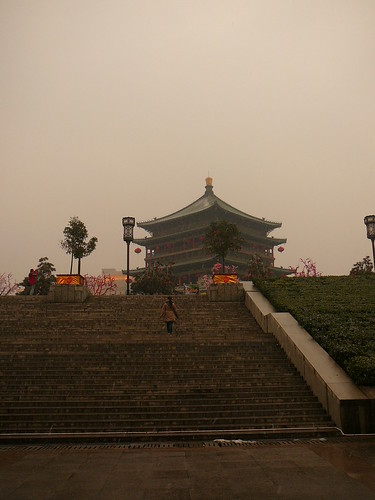
I came to Xi’an five years ago as a side trip on my way to Mongolia. I came to see the Terracotta warriors, do some laundry and move on. I have a bad memory for images and I have only two strong memories of the place. The first was a dingy little restaurant where dog was an option on the menu and another customer teased me for how I hold my chop-sticks. The other was the long line of shops along my hotel’s street; little one room beauty salons lit by pink lights, all with solitary women sitting at the front doors, calling out to me as I went by.
Xi’an was not a place I gave much thought to returning to. I decided to try it again because a friend in Istanbul recommended it. He pointed out that it was a beautiful city with a lot of universities which lent it a college-town vibe. These good words, plus the knowledge that it was neither a big industrial town nor a sleepy backwater made me gravitate toward it. It would be good, I imagined, to be in a place that was both Chinese and yet full of western amenities when necessary.
Well, Xi’an was a far cry from what I remembered. Five years had done a number on the city. When I’d stayed here before, the Lonely Planet had recommended a clean, but boring little hotel near the train station—which goes some way to explaining the concentration of brothels. Now there were swanky youth hostels with fancy expat bars lighted like Wan Kar Wai movies.
So what is Xi’an? Well, with around 7 million people, it probably qualifies as a second tier Chinese city. But that doesn’t convey much. What matters is that it’s the original capital of the country—the Qin, Han and Tang all had their palaces here—and, history aside, it’s the largest city in the northwest of the country. If you look at a map of the country, the population (marked in shades of red) is all concentrated on the coast. Outside the Great wall, the intensity fades except for a flame of color flaring out westwards to include Xi’an before petering out. Think of Xi’an like Chicago—a mecca of commerce amid vast expanses of nothing.
Living in a place, the layout and the points of interest only slowly come clear. A travel guide will tell you to visit the Big Goose Pagoda and the Bell Tower, perhaps a visit to the history museum and a few other cultural sights, but this isn’t how daily life plays out. In practice, most of my time is spent within a radius of only a few blocks.
Both my job and apartment are located only two blocks from the Bell Tower and, from this six hundred year old structure, the four main city boulevards radiate off toward the old city walls. Along the west road are numerous fancy restaurants. Along the north, shopping malls. South, more shopping malls. East? Individual clothing stores, banks, and a few hotels. Behind the Bell Tower, in the northwest section, is the “Muslim Quarter,” a recently refurbished drag of little stores selling dried fruit, noodle shops, and vendors hawking knick-knacks like wood-carved frogs.
My house is in the southeast section of the old city near the gargantuan Taiyuan Shopping center and the surrounding clothing and accessory stores. To get to it you take a few turns off the main streets. You quickly find yourself walking along a scruffy alleyway. There’s a flop motel, a few legitimate hair salons and an open air shack selling stale crackers and water before you come to my apartment block.
If you pass by my apartment, you emerge back on a small road running parallel to the main eastern thoroughfare, lined with a mixture of middle, low and basement range restaurants. Scattered along the way are a range of different shops—internet cafes, corner-groceries, bakeries, pirated electronics boutiques and sign-makers.
Not too far from all this is my school, located on the fifth floor of a building shared with a business hotel and a large bookstore. Directly next to it is an empty lot of property. Hidden from the street by a concrete wall, it has become home to a small shanty town of beat-down-looking men. Using scavenged bricks, plastic, wood and other materials, they’ve constructed little huts. There are meeting places with tables and chairs at which they play cards. The men gather together throughout the day around trash bin bonfires.
In the past month, I’ve made it east and south of the city walls repeatedly, but never penetrated in the other directions. The south of the city is chock-a-block with universities and concentrations of clothing stores and restaurants. There is also a financial district with big clean roads, but not much in the way of vitality.
The main southern draw is the Goose Pagoda. Any potential awe the view of this thirteen hundred year old temple might have stirred on my first visit was undercut by the surrounding tourist infrastructure. In my first glimpse of it on a foggy morning, the pagoda seemed dwarfed by a massive KFC built on the edge of the surrounding square. In all directions, new restaurants are going up. All along the westerly running Yanta Street are model foreign restaurants serving Korean, Maylay, Japanese and Indian cuisines. Everything is newly built and, like so much of the development, its existence seems more aspirational than anything else. On the day I visited, every restaurant was empty and the staffs sat at window tables playing cards or gazing.
Such details aside, the whole area seemed promising. There was a cute little park that I could imagine visiting in the summertime and at night the fountains around the pagoda were turned on to provide audiences with the largest light and water show in China.
One particular disappointment to me was that the university district of the city was largely devoid of interest. Nothing distinguished it from other parts of city. There was nothing special in the way of bookstores, restaurants or cafes . . .
And, really, this was the biggest problem with the city as a whole—the undifferentiated sameness of it all. Aside from the landmarks, there was little beauty on display. Life centered around shopping, work, restaurants and home—and nothing would be wrong with this except that the shopping all seemed so repetitive. On a typical day, waking up to cold weather, there was little motivating me to explore and, when I did, the explorations tended to reveal large swaths of sameness. There might be a particularly good restaurant in a given neighborhood, but the surrounding area offered little of interest.
Again and again what saves China from boring me with its alternatively drab, soulless city vistas, is the people. This isn’t to say that Chinese are more interesting than folks in other countries—that the opposite is true is a gripe of a different sort—but they are more friendly and the flow of life around them hums at some higher frequency.
Certain things that grate on one at first—the constant stares and murmurs of laowai and waiguoren—lose their annoyance when their lack of malice becomes clear. Chinese stare because they’re interested and involved. If you have a problem, people will help you. If you are in trouble, you never feel utterly alone.
Moreover, to my eye, daily life in China gives lie to the stereotype (repeated by Chinese themselves), that they are meek and easily herded. I am constantly watching shouting matches break out. Getting on a bus in a free-for-all. And traffic! There are no rules; buses don’t’ stop for pedestrians on red lights, pedestrians don’t wait for green lights (instead you just wander out into the road, lane by lane). All this—and far better examples of such collective madness—are pluses in my way of thinking. When you start considering your own life, back in the states, you realize how regimented everything is. you go when you’re told, stop when you’re told, line up here, queue there. You don’t spit on the street or drive down the sidewalk. You also don’t fall easily into friendship with strangers.
It’s all of a piece; neither good nor bad but thinking makes it so. Xi’an is lacking in a great many departments that matter to me, but it brims with life in a host of other ways.
New Year’s Eve was a perfect example. In the days leading up to the event, streets are peppered with vendors selling fire-crackers. For several days in advance, people set off sporadic blasts with no rhyme of reason. As the midnight hour approaches, the frequency rises until midnight when fireworks start shooting off in every direction. The entire sky becomes full of explosions, lights and smoke.
More quietly, along the streets, outside businesses and—occasionally—in the middle of the highway, Chinese gather in twos and threes to light small devotional fires of money and joss paper.
Amid all this activity, groups of Chinese head to and fro to restaurants or each other’s houses. Everyone out and about is in high spirits. As I walked along with a few other teachers, packs of kids called out new years greetings.
Finding ourselves shunted onto the street when the expat bar finally showed us the door at five in the morning, we teachers made our way onto the streets and began to part ways. Another teacher and I were waylaid by a group of Chinese in their late twenties: Three very drunk men and a pair of slightly tipsy women. Seasons greetings were exchanged and, after some discussion in various broken languages, we all agreed to get food together. Our new Chinese friends had no particular idea of where to go, but an hour of peripatetic wandering brought us to a busy noodle place near the Muslim Quarter.
Around seven in the morning we all said our goodbyes and started to head home. Light was flooding the city’s perpetually gray sky and fireworks were starting up again.












Tidak ada komentar:
Posting Komentar